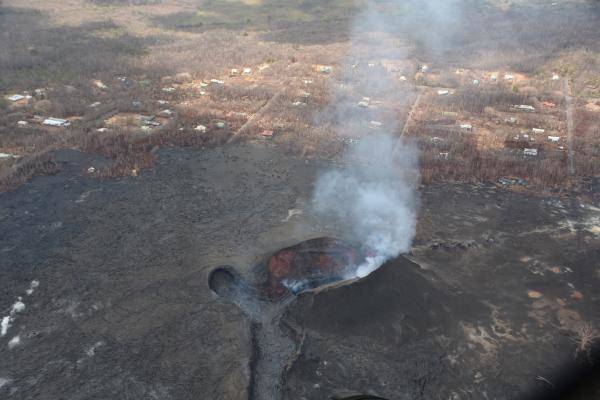HILO — Hawaii County officials are putting construction of an alternate route for Highway 11 on hold for the time being as the lull in the Kilauea eruption continues.
But planning and right-of-way acquisition are continuing in case the bypass near Volcano village is needed, according to Barett Otani, county Public Works spokesman. The project is anticipated to cost $500,000, he said in an email.
The alternate route from Piimauna Drive to Volcano Road was discussed a week ago after the highway sustained damage from numerous earthquakes caused by the collapse events in the nearby Kilauea caldera.
Those have since stopped, along with any sign of subsidence within the caldera. The last collapse event was Aug. 2.
As of Thursday, Kilauea remained quiet at both the summit and lower East Rift Zone.
Hawaiian Volcano Observatory spokeswoman Janet Babb said there was no lava leaving fissure 8, where a lava pond has dropped and begun to crust over. Meanwhile, geologists are scouring the volcano for clues as to whether this is a brief pause or a sign of more long-term change.
“We’re watching it closely for any indication that might change, no matter how subtle,” she said.
Pauses in eruptions are common, and were seen during the Pu‘u ‘O‘o eruption and twice during the 1955 lower East Rift Zone eruption. Breaks in the ’55 eruption lasted five and 16 days.
According to HVO, output of the eruption, which started May 3 in Leilani Estates, started to decrease significantly Saturday. The only signs of lava were at ooze-outs, mostly along the ocean entry, where lava is still moving under the crusted surface of the lava channel. Babb said the flow field remains hazardous.
Potential warning signs of a return of magma to fissure 8 or elsewhere include an increase in gas emissions, seismic changes, or new and expanding ground cracks. There were no such signals as of Thursday, though several fissures were steaming.
An intermittent and wispy steam plume was seen at Pu‘u ‘O‘o, but emissions there remained at typical levels for the past three months, when the eruption moved from that site into Leilani Estates.
Any change might occur without warning, though scientists are confident their instruments, much more sophisticated than during previous eruptions, will pick up on the signals.
“It gives you pause, when you read that (1955) account,” Babb said, when the eruption restarted without warning. “We think we have a better handle on what’s happening, with more sophisticated instruments and a greater number of instruments on the lower East Rift Zone.”
The lower rift zone eruption, which saw the largest lava output in the past two centuries, was being powered by the draining of the magma reservoir under Halema‘uma‘u, a process that also was causing the caldera floor at the summit to sink. Babb said more magma was leaving the reservoir than entering into it.
For now, she said it appears the volcano has reached a state of equilibrium.
Babb said the pause could be caused by a change in magma supply to the rift zone or a blockage in the system. She said the latter is less likely.
“There are a variety of possibilities,” she said. “Right now, it’s hard to say, but it’s truly wait and watch.”
Email Tom Callis at tcallis@hawaiitribune-herald.com.

